Multivariate probit model
| Part of a series on Statistics |
| Regression analysis |
|---|
 |
| Models |
| Estimation |
| Background |
|
In statistics and econometrics, the multivariate probit model is a generalization of the probit model used to estimate several correlated binary outcomes jointly. For example, if it is believed that the decisions of sending at least one child to public school and that of voting in favor of a school budget are correlated (both decisions are binary), then the multivariate probit model would be appropriate for jointly predicting these two choices on an individual-specific basis. This approach was initially developed by Siddhartha Chib and Edward Greenberg.[1]
Example: bivariate probit
In the ordinary probit model, there is only one binary dependent variable and so only one latent variable is used. In contrast, in the bivariate probit model there are two binary dependent variables and , so there are two latent variables: and . It is assumed that each observed variable takes on the value 1 if and only if its underlying continuous latent variable takes on a positive value:
with
and
Fitting the bivariate probit model involves estimating the values of and . To do so, the likelihood of the model has to be maximized. This likelihood is
Substituting the latent variables and in the probability functions and taking logs gives
After some rewriting, the log-likelihood function becomes:
Note that is the cumulative distribution function of the bivariate normal distribution. and in the log-likelihood function are observed variables being equal to one or zero.
Multivariate Probit
For the general case, where we can take as choices and as individuals or observations, the probability of observing choice is
Where and,
The log-likelihood function in this case would be
Except for typically there is no closed form solution to the integrals in the log-likelihood equation. Instead simulation methods can be used to simulated the choice probabilities. Methods using importance sampling include the GHK algorithm (Geweke, Hajivassilou, McFadden and Keane),[2] AR (accept-reject), Stern's method. There are also MCMC approaches to this problem including CRB (Chib's method with Rao-Blackwellization), CRT (Chib, Ritter, Tanner), ARK (accept-reject kernel), and ASK (adaptive sampling kernel).[3]. A variational approach scaling to large datasets is proposed in Probit-LMM (Mandt, Wenzel, Nakajima et al.).[4]
References
- ↑ Chib, Siddhartha; Greenberg, Edward (June 1998). "Analysis of multivariate probit models". Biometrika. 85: 347–361 – via Oxford Academic.
- ↑ Hajivassiliou, Vassilis (1994). "CLASSICAL ESTIMATION METHODS FOR LDV MODELS USING SIMULATION". Handbook of econometrics.
- ↑ Jeliazkov, Ivan (2010). "MCMC PERSPECTIVES ON SIMULATED LIKELIHOOD ESTIMATION". Advances in Econometrics. 26.
- ↑ Mandt, Stephan; Wenzel, Florian; Nakajima, Shinichi; John, Cunningham; Lippert, Christoph; Kloft, Marius (2017). "Sparse probit linear mixed model" (PDF). Machine Learning. 106: 1–22. doi:10.1007/s10994-017-5652-6.
Further reading
- Greene, William H., Econometric Analysis, seventh edition, Prentice-Hall, 2012.